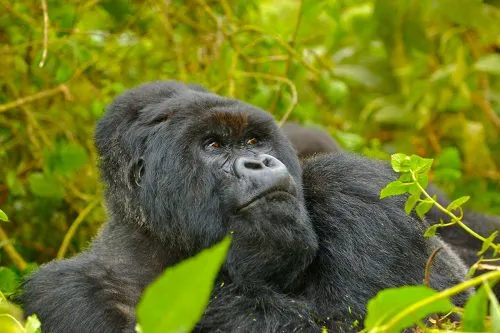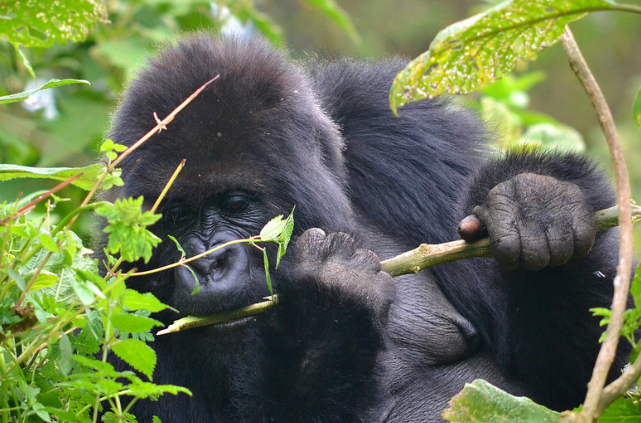
Gorilla Trekking and Wildlife Safaris in Rwanda
Gorilla Trekking and Wildlife Safaris in Rwanda: Hiking the rainforests and slopes of stunning mountains to see mountain gorillas and golden monkeys up close? Hacking through humid rainforests in quest of colobus monkeys and chimpanzees? Going on safari in a crowdless, rapidly replenishing national park where you can see the Big Five? Rwanda has outstanding wildlife watching possibilities in spectacular scenery.
Tracking Mountain Gorilla and Golden Monkeys in Volcanoes National Park.
The Virunga volcanoes, which create a formidable natural barrier between Rwanda, Uganda, and the Democratic Republic of the Congo, are where Rwanda really gets the epithet ‘Land of a Thousand Hills.’
The spectacular Rwandan Virungas are protected by the country’s major attraction, Volcanoes National Park. Some of the world’s few surviving mountain gorillas live here, hiding among the bamboo woods that cover the hills.
Many people consider an up-close experience with these intriguing creatures while gorilla tracking (US$1500 per person, which covers park admission, and necessary park guides fees) to be the highlight of their vacation to Africa.
A close encounter with a silverback male gorilla may be a terrifying experience, especially if you’ve only ever seen enormous wild creatures from the comfort of your automobile. Despite their frightening size, gorillas are wonderfully non-aggressive animals, completely vegetarian, and extremely safe to be near.
Park rangers will give you a safety briefing before you go to track the habituated gorilla groups, which number ten in Volcanoes National Park. The largest group has more than 30 people. Some groups are easy to discover, while others are more difficult to approach and take a three- to four-hour effort.
You will most certainly trek through dense foliage up steep, muddy hillsides, occasionally reaching elevations of more than 10,000 feet (3000 meters). Regardless of the group you wind up chasing, you’re sure to have an unforgettable experience.
Visits to the gorillas are limited to one hour. tourists are instructed to stay at least 15 feet (5 metres) away from the gorillas at all times, yet it is not unusual to witness some gorillas attempting to engage with tourists – an unforgettable wildlife experience!
Bookings for gorilla permits can be done at the Rwanda Development Board tourism office in Kigali or via a Rwandan tour company. Those traveling on a tour package will have everything planned for them, whilst independent travelers can acquire permits by making reservations early on.
While most people are obviously drawn to the prospect of meeting genuine gorillas in the mist, rare golden monkeys, a colony of which have become accustomed to human interaction, may also be seen. These gorgeous and lively monkeys bound among the branches of larger trees, more like chimpanzees rather than gorillas.
Golden monkeys, a subspecies of the more widely distributed blue monkey, are characterized by their gold body pigmentation, which contrasts dramatically with black patches on their extremities. Golden monkeys are an endangered species found exclusively in the Virungas. Golden Monkey Permits (US$100) to track golden monkeys are easy to get.

Chimpanzee, Colobus Monkey Trekking and Bird Watching in Nyungwe Forest National Park.
Nyungwe Forest National Park, located in Rwanda’s southwest, is the country’s most significant biodiversity hotspot, with over 1000 plant species, 13 primates, 75 other animals, at least 275 bird species, and an incredible 120 butterfly species. It was recently classified as a UNESCO World Heritage Site.
Despite its vast biodiversity, Nyungwe Forest National Park is relatively unknown outside of East Africa. Its main selling point is the opportunity to follow chimpanzees, who have become accustomed to human visits over the years.
Similar to gorilla tracking, you should be prepared for extensive walks that can last up to a number of hours. However, the flora on the forest floor is much less dense than in the Virunga highlands, where the gorillas dwell, thus the trip is often less strenuous.
In the wet season, there is a fair probability of successfully tracking the chimpanzees on the colored trails (a network of routes with increasing levels of difficulty), but in the dry season, they tend to migrate for higher elevations.
While chimpanzees receive the majority of the attention in Nyungwe forest national park, sightings of armies of other monkeys, notably Angolan colobus monkeys, are almost certain. Angolan colobus is an arboreal monkey with black fur and long, silky white hair. The colobus monkeys may be found across equatorial Africa’s rainforests, although they are most abundant in Nyungwe Forest National Park.
Although they may not be as charismatic as chimpanzees, colobus monkeys are incredibly sociable primates who form massive groups – one of Nyungwe’s two semi-habituated battalions has no less than 500 members. Finding yourself in the company of literally hundreds of monkeys jumping through the treetops may be a fascinating experience. Colobus monkeys in Nyungwe forest national park are naturally curious creatures who appear to enjoy their lively encounters with human visitors.
Troops of Angolan colobus keep well regimented territory, which is excellent news for anyone constructing a colobus track, since the semi-habituated group in Nyungwe forest sticks to the colored routes. In most cases, trackers can locate the colobus monkey tribe within an hour.
Nyungwe Forest National Park is by far the country’s best birding destination, with over 300 bird species, including 27 endemics. The paved road through the park allows visitors observation at all altitudes of the forest: expect to see mountain buzzards and cinnamon-chested bee-eaters sitting along the way, as well as numerous sunbirds, wagtails, and waxbill groups.
Other common birds seen include francolins, turacos, African crowned eagles, hornbills, and even Congo bay owls. Experienced birdwatchers can schedule a trip with one of Nyungwe’s experienced birding guides.
Viewing the Big Five in Akagera National Park.
Akagera National Park, a treasure of Eastern Rwanda, is becoming increasingly popular among safari aficionados. Although it cannot match (yet) with its counterparts in Uganda, Kenya or Tanzania, the stunning vistas, diversified ecosystems, and abundant animals make the journey worthwhile.
It is now a must-see on every Rwandan itinerary due to strong conservation legislation, good management, the reintroduction of lions and black rhinos, the renovation of ancient camps, and the construction of new ones.
The park has three distinct environments: standard savannah, as seen throughout the region; an enormous swampy area along the Tanzanian border that contains six lakes (great for boat trips) and numerous islands, some of which are covered in forest; and a chain of low mountains on the park’s flanks with variable vegetation, ranging from short grasses on the summits to wooded savannah and dense thickets of forest.
Wildlife is diverse. Akagera’s carnivores are confined to leopards (approximately 150 individuals), hyenas, genets, servals, and jackals. What about lions? In 2015, seven people were flown from South Africa to Rwanda by chartered jet and then transferred to Akagera. There are now around 50 lions in the park. In 2017, 18 black rhinos were introduced to Akagera, followed by 30 white rhinos in 2021.
Elephants, the park’s other huge ‘trophy’ animals, are believed to number 90 and are frequently sighted. Buffalo are also abundant (about 3000), as are hippos and crocodiles in the lakes. Antelope and other plains wildlife are highly represented, however herds are tiny and the animals are timid.
Impala, topi, zebra, and waterbuck are all common safari animals, as are the stately but uncommon roan antelope and the small Oribi. Maasai giraffes, which were never native to the park, have been imported and are doing well.
The banks of Lake Ihema are also ideal for birdwatching. The beautiful thing about Akagera is that there aren’t many other wildlife-viewing drivers, so you can enjoy the park’s magnificent environment in relative privacy and isolation. Invaluable!


